The Bay Trail Preview: Intel Atom Z3770 Tested
by Anand Lal Shimpi & Brian Klug on September 11, 2013 12:00 PM ESTOur Windows performance analysis takes place on Intel's Bay Trail Form Factor Reference Design. The 10-inch tablet features a 2560 x 1440 display, 2GB of LPDDR3-1067 memory and a 64GB eMMC solution. The platform was running Windows 8.1 (32-bit).
Intel left me to install and run anything I wanted to during a period of a few hours at their campus in Santa Clara. I got a feel for the speed and snappiness of Bay Trail during my benchmark setup/installation process. While I don't believe Clover Trail was really usable in Windows 8's desktop mode (it was just too slow), the same is definitely not true for Bay Trail. With the exception of a few benchmark installs or loads that simply took forever, my Bay Trail experience was really quite good under Windows. Bay Trail is obviously not as fast as Haswell when it comes to general usage, but it's definitely worthy of a discussion. Whether or not it actually is good enough for an entry level machine will depend on how OEMs choose to configure their Bay Trail systems. I'll hold off on a final verdict here until we have some time with final Bay Trail devices and not just FFRDs.
Intel already teased the Atom Z3770's multithreaded Cinebench performance, but what about single threaded performance? Remember that single threaded performance is often a signfiicant contributor to things like application responsiveness.
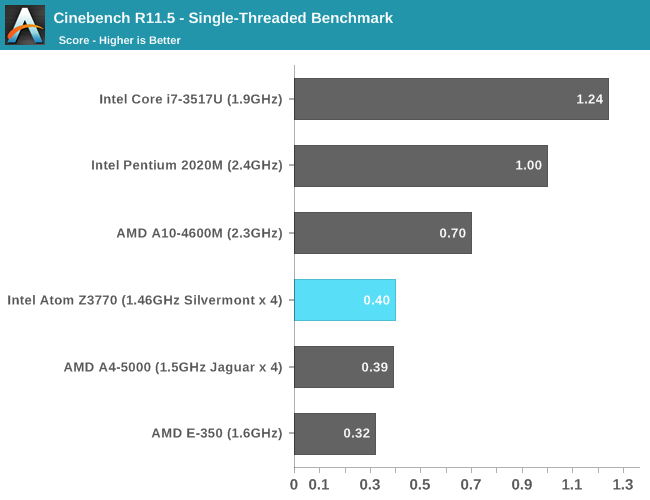
The single threaded performance numbers are just barely ahead of AMD's Jaguar based Kabini SoC. The big difference however is power. I had Intel measure SoC power at the board level while running a single threaded Cinebench 11.5 run on the Atom Z3770 and saw a range of 800mW - 1.2W. AMD on the other hand lists the A4-5000's SoC/APU idle power as 770mW. I don't have equivalent data for AMD, but with the A4-5000 idling at 770mW, it's safe to say that SoC level power consumption is lower on Bay Trail. The A10-4600M/Trinity comparison is interesting as it really helps put Bay Trail's performance in perspective as well.
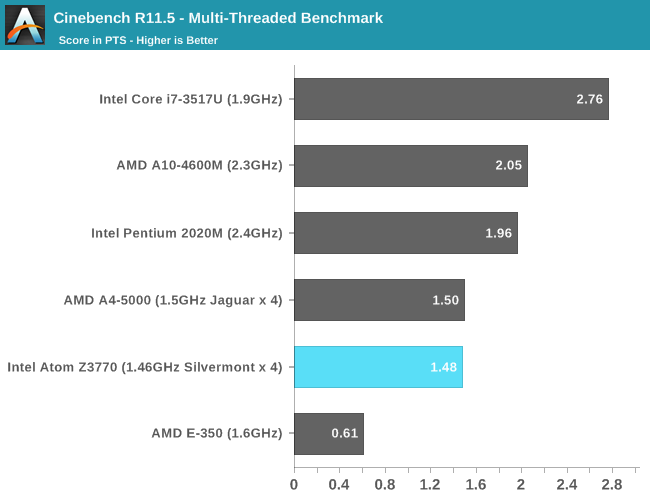
Multithreaded performance puts Bay Trail and AMD's Kabini at similar performance levels. Once again, looking at SoC power however the Atom Z3770 pulls around 2.5W in this test. Looking at the increase in platform power for the A4-5000 here, I'm assuming that the equivalent data for AMD would put Kabini in the 6W range. Multithreaded performance comes very close to the Pentium 2020M, but that's really overstating the strength of Bay Trail here as the Atom Z3770 has twice as many cores as the Pentium 2020M.
Single threaded integer performance is likely more useful to know, especially given Bay Trail's target market. For a rough idea of what to expect there, we turn to 7-Zip's built in benchmark. The dataset footprint is large enough to require main memory accesses, making this benchmark a little more interesting than it otherwise would've been. I unfortunately don't have access to all the CPUs here, so the 2C/4T 1.9GHz Core i7 3517U turns into a 2C/4T 1.7GHz Core i5 3317U as it's the only comparison data I had handy:
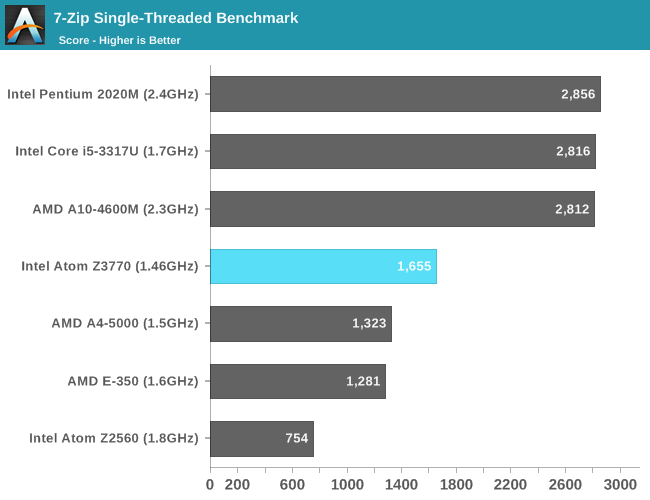
While Silvermont's single threaded FP performance seemed identical to Jaguar, its single threaded integer performance is much higher in the 7-Zip benchmark. Here the Atom Z3770 is 25% faster than the A4-5000. Looking further up the list however, there's still a healthy gap between thermally constrained Ivy Bridge Ultrabook class parts and the best Bay Trail has to offer. In this case Surface Pro's silicon is 70% faster than Bay Trail. Depending on your perspective that's either a huge difference or remarkably small given how wide the previous Atom to Core gap was.
7-Zip also features a multithreaded benchmark. Here we're looking at the same workload, but now split across all available cores/threads:
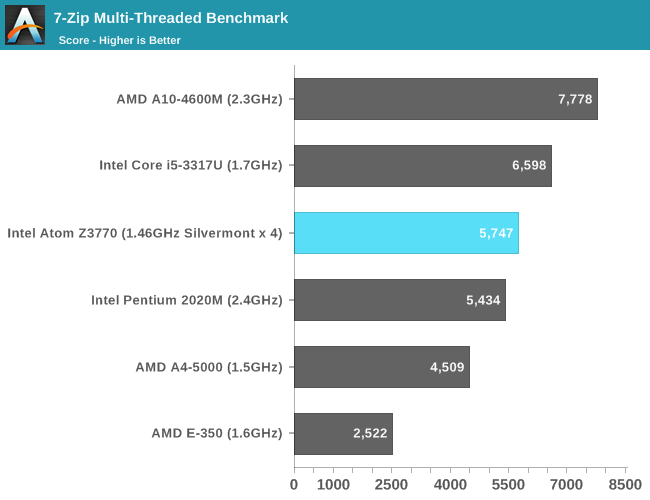
In multithreaded integer workloads, the Z3770 gets dangerously close to Ivy Bridge levels of performance. Again, we're overstating Bay Trail's performance here as the Z3770 has four cores while the Core i5-3317U only has two (but with Hyper Threading presenting another 2 virtual cores). I don't believe most tablet workloads are heavily threaded integer workloads, however the world is hardly single threaded anymore. The reality is that a quad-core Bay Trail should perform somewhere between 40% - 80% of a dual-core Ivy Bridge.
For what its worth, Bay Trail SoC power during the multithreaded 7-Zip benchmark was between 1.9W - 2.5W. At this point there's no question in my mind that Silvermont and Bay Trail are truly tablet-class power consumers.
Our next tests are browser based benchmarks that, once again, hope to characterize Bay Trail's performance in a manner that's more representative of lighter client workloads:
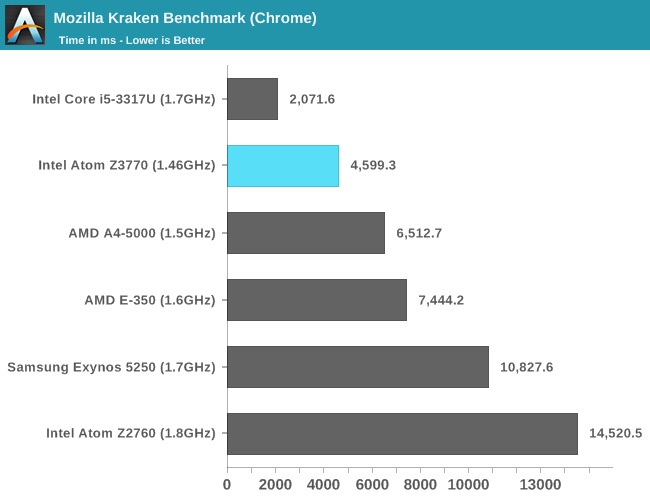
The Silvermont vs. Jaguar comparison shows a 29% advantage for Intel. Looking back at Clover Trail vs. Bay Trail, the performance improvement is staggering. Intel improved performance by over 3x at this point. The 17W Ivy Bridge vs. Bay Trail comparison continues to be interesting. Here the Core i5-3317U completes the Kraken test in half the time of the Atom Z3770.
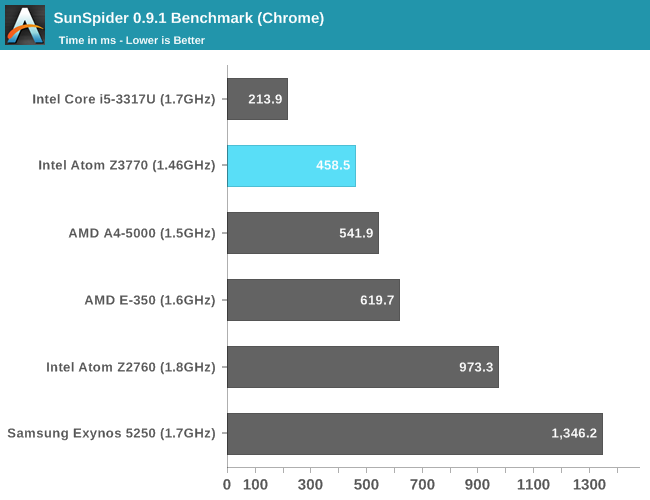
The Silvermont/Jaguar gap in SunSpider shrinks a bit in SunSpider. Bay Trail is still over 2x faster than Clover Trail, and Ivy Bridge remains over 2x the speed of Bay Trail.
For our final light CPU workload test we have PCMark 7. This is an interesting benchmark as it takes into account the storage subsystem a bit. Keep in mind here that the Bay Trail system is using eMMC based storage, while all of the others are using a standard SSD (Samsung SSD 830):
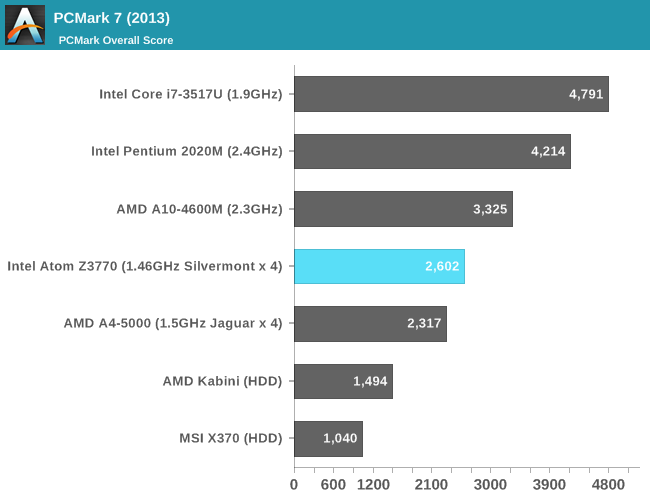
As we saw earlier, Bay Trail can make up for its single threaded performance by doing quite well in multithreaded tests. PCMark 7 attempts to present a mixed workload view of Bay Trail's performance and the result is relatively similar to AMD's Jaguar based A4-5000 Kabini APU. AMD's Trinity ends up being just under 30% faster than Bay Trail, while 17W Ivy Bridge is 60% faster. Overall platform performance is definitely not bad at all as long as the OEM does a good job specing the device. In this case the Samsung eMMC solution in the Bay Trail tablet reference design was surprisingly decent.
GPU Performance
Arguably the more interesting CPU and GPU tests will come in the Android section but I borrowed some Android data from our Kabini review and ran through 3DMark, GFXBench 2.7 and some lighter Steam games:
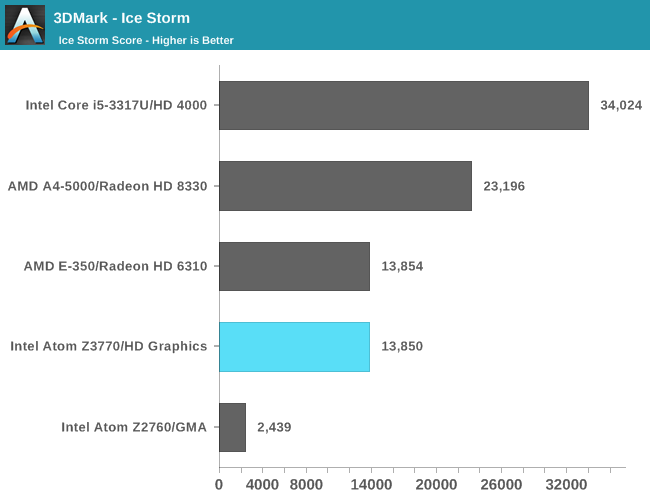
Bay Trail's overall 3DMark Ice Storm score (720p) is about on par with Brazos rather than being a competitor for Kabini. Bay Trail's HD Graphics core is based on Ivy Bridge and it's a cut down implementation at that.
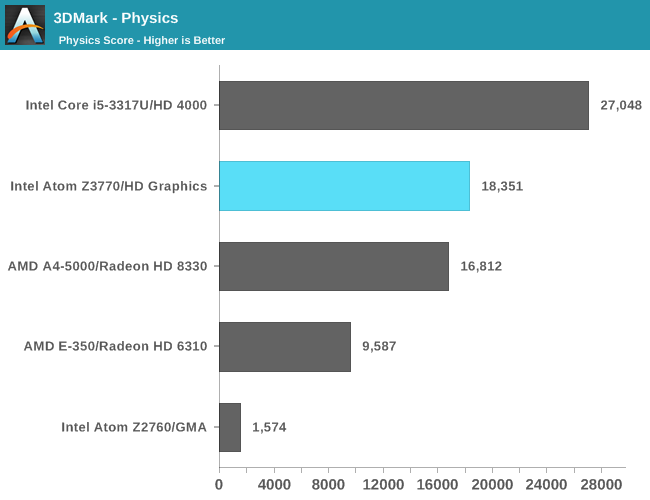
3DMark's Physics test is basically a multithreaded CPU benchmark, which allows the Z3770 to pull ahead of the A4-5000.
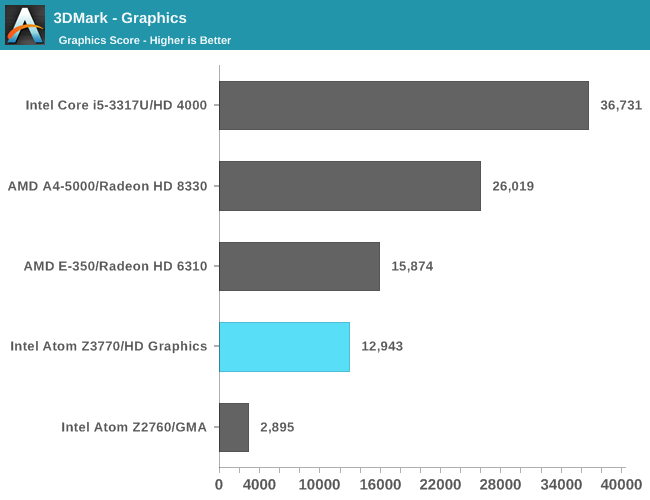
If we isolate graphics alone however, the Z3770 once again falls behind Brazos.
GFXBench 2.7's T-Rex HD test seems to agree with what 3DMark tells us:
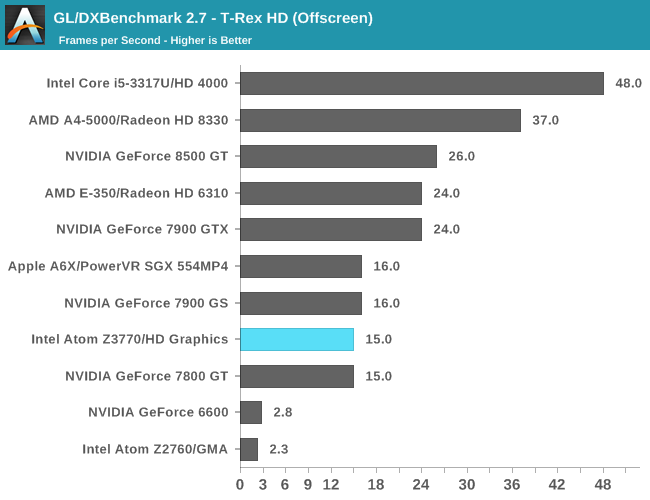
Obviously under Windows we have more opportunities to benchmark actual game performance. I turned to the lighter (1366 x 768, low quality) game benchmarks I ran for our HD 5000 comparison. I had to exclude Super Street Fighter IV as a driver problem kept it from running on the Bay Trail FFRD.
In a couple of cases Bay Trail delivers roughly half the GPU performance of a 2011 11-inch MacBook Air, but in a much lower power package. Minecraft saw a bigger gap at 1/3 the performance. None of these games are really playable, but that doesn't mean others aren't. I was able to play Team Fortress 2 on Intel's Bay Trail FFRD (with a Bluetooth keyboard and mouse of course) at reasonable frame rates. The system would chunk occasionally but for the most part it was relatively quick. Obviously Bay Trail's graphics are better suited for lighter tablet games.
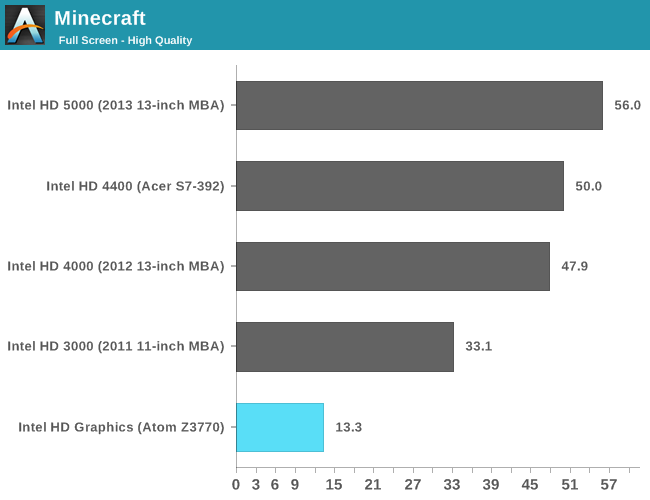












190 Comments
View All Comments
name99 - Wednesday, September 11, 2013 - link
Uhh, his point is COMPLETELY valid.The actually existing usage models of these devices is very much short sprints for which high throughput is ideal, followed by long bursts of doing nothing. Yes, this doesn't match a particular class of games, and doesn't match whatever weird inappropriate process (like cinebench) that you want to run on your phone, but it matches how MOST people uses their phones (and tablets).
This is the one area where, IMHO, Intel have a clear advantage over ARM. But I suspect it is very much a temporary advantage. Apple, for example, obviously spent all their A7 design time getting the 64-bit in place, and on the remaining low-lying micro-architectural fruit. But I expect that for the next chip, this sort of ability, to turbo up to high frequencies for short periods of time, will be their primary focus.
romanov123 - Wednesday, September 11, 2013 - link
Well, how about Skype/Google hangouts or watching a movie? Most turbo benefits will also show up in launching apps.And as you say Apple still needs to figure out Turbo while Intel has launched a product with it.
Valis - Wednesday, September 11, 2013 - link
No x64? Guess I wont be getting one of these, right now then. I'd rather run Ubuntu on it than Android, since the latter is better for smartphones. Ubuntu being based on my beloved Debian that I have been using since the stoneage of linux. =)blandge - Wednesday, September 11, 2013 - link
Bay Trail supports 64bit for Windows and Linux.Valis - Wednesday, September 11, 2013 - link
Quote:"Although the core architecture is 64-bit in design, there will be no OS support for 64-bit Bay Trail at launch. Windows 8.1 with Connected Standby appears to still be 32-bit only, and obviously Android is 32-bit only at this point as well."
So, it's just the drivers and such missing? Ohh, okej then. :)
lmcd - Wednesday, September 11, 2013 - link
Yeah it's just the power optimizations landed in 32-bit first (probably easier plus 32-bit is all that's needed for these LP devices)RU482 - Wednesday, September 11, 2013 - link
Yeah, they said CedarTrail was supposed to have 64-bit support to, but then pulled the rug at the last moment. These BayTrail-t CPUs are going to be so short lived, don't expect much from Intel support after about January (if that long). They dedicate the resources to Airmont-tzeo - Wednesday, September 11, 2013 - link
Cedar Trail technically did but because it used Imagination GPU the driver support never materialized, especially after Intel decided to give up on netbook range ATOM and re-purposed it for the mobile market. Even some of the D Series Cedar Trail models were terminated in the same year of release.Bay Trail, though is using Silvermont architecture that is fully 64bit and is using Intel's own GMA based on a scaled down version of the Ivy Bridge HD4000... and Linux support for Intel's driver support was added back in April btw!
The only thing is Intel isn't pushing the 64bit advantage for mobile devices but Bay Trail is also going into Laptops and desktops/servers... specifically the Bay Trail M and D series that'll be sold under the Celeron and Pentium Brand names will be when they push the 64bit advantage but since it's the same architecture it means you should be able to get drivers for all Silvermont based devices...
Freddo - Wednesday, September 11, 2013 - link
I look forward to the day when these energy efficient processors are powerful enough to properly run a PS2 emulator, but it seems like I have to wait a few more years still.Dentons - Wednesday, September 11, 2013 - link
Yes, it's better than ARM, but is it better enough?Clearly, the answer is no. For most tablets and phones, it's not nearly better enough.
Convincing existing ARM vendors to move to Intel will not be an easy task. There will be huge costs involved. In order to drive such a move, Intel would need far better performance or a far better price point, but probably both. It seems unlikely that Intel has either. The performance is only minimally better than ARM's current offerings, and while we don't know pricing, given that Intel has the highest margins in the industry and ARM among the lowest, one must assume that Intel's new silicon won't be price competitive with ARM.
So where will these chips shine? The only place they seem likely to find a home is in full (non-RT) X86 Windows 8 tablets and phones. Windows is the only large mobile player that requires X86. For the rest of the market, X86 is a liability.
Intel may mark this a success if it kills off Windows RT. In that singular goal, these chips seem likely to succeed. Such a victory will do little to make Intel powered tablets competitive with Android. Full X86 Windows boxes will have the full duo of WinTel taxes. Because of this, it's hard to see these products ever being price competitive with Android, not to mention the dearth of mobile apps on the Windows platform.
Intel and Microsoft have allowed ARM and Android too large of a head start. Now, their lead may be nearly insurmountable.